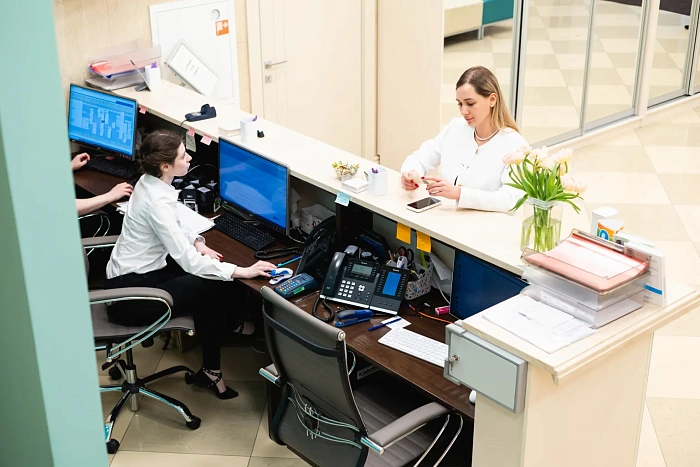Colposcopy procedure
A procedure in which a doctor can use a colposcope to examine the vagina, cervix and vulva, examine the mucous membrane in detail and identify abnormal changes that may be a sign of diseases.

Colposcopy is used to identify pathologies of the cervix, vagina and vulva. The procedure is useful in the presence of abnormal Pap smear results (Pap test) and in the detection of oncogenic types of human papillomavirus.
Benefits
High diagnostic accuracy
Colposcopy allows you to detect abnormal changes in the mucous membrane of the cervix with high accuracy.
Painlessness
The procedure does not cause pain and is accompanied by minimal discomfort.
The possibility of a biopsy
The doctor can immediately take a biopsy of suspicious areas, which speeds up the diagnostic process.
A wide range of applications
Colposcopy is used for diagnosis, post-treatment monitoring, and routine checkups.
Preparation for colposcopy
Before colposcopy, it is recommended to refrain from sexual intercourse, the use of vaginal products and douching 24-48 hours before the procedure. The procedure should be performed outside the menstrual period, as bleeding can make examination difficult.

Colposcopy procedure
The doctor inserts a mirror into the vagina to provide access to the cervix. A colposcope equipped with magnifying lenses and a light source is placed at a distance from the vagina and does not touch the patient's body. The doctor treats the cervix with special solutions for better visualization of abnormal areas. The procedure takes about 10-20 minutes and may be accompanied by slight discomfort, but is not painful.

Recommendations after the colposcopy procedure
After the colposcopy, you can immediately return to normal business. If a biopsy has been performed, light spotting and discomfort may occur for several days. It is important to follow the doctor's recommendations and consult him in case of severe pain, heavy bleeding or signs of infection.

Врачи
Смотреть всех врачейIndications and contraindications
Indications
Abnormal Pap test results or high-risk HPV detection
In the presence of abnormal cells detected during cytological examination of the smear.
Suspected dysplasia or cervical cancer
For a detailed examination and confirmation of the diagnosis in case of suspected precancerous or malignant changes.
Changes on the mucous membrane or skin of the vulva
It helps to identify pathological changes in the mucous membrane and / or skin and clarify the diagnosis.
Control after treatment of precancerous conditions
To monitor the condition of the cervix after treatment of dysplasia or other precancerous changes.
Expected effect
Accurate diagnosis
Colposcopy allows you to identify and evaluate changes in the mucous membrane of the cervix, such as dysplasia, erosion and signs of infection.
Early detection of precancerous conditions
The procedure helps to detect precancerous changes in the early stages.
The possibility of a biopsy
The doctor can take tissue samples for biopsy directly during the procedure.
Monitoring of the condition after treatment
Colposcopy is used to monitor the condition of the cervix after the treatment of precancerous conditions.
Similar referral activities
Consultation of a gynecologist
Medical examination aimed at diagnosing, treating and preventing diseases of the female reproductive system.
Removal of tumors in the intimate area
A procedure aimed at eliminating benign growths such as papillomas, warts, cysts and genital warts.
Cervical plastic surgery
Cervical plastic surgery (tracheloplasty) is a surgical restoration of the anatomical structure and function of the cervix, which helps to maintain the health of the reproductive system.
Treatment of vulvar diseases
Vulvar diseases, including chronic fissures, sclerotrophic lichen and other dermatological conditions. We offer modern and effective treatment methods aimed at reducing symptoms and restoring the normal condition of the vulva skin.
Correction of menopause problems
The onset of menopause is often accompanied by a number of physical and mental manifestations unpleasant for a woman. The gynecologist will choose therapy, which can relieve or completely eliminate the symptoms.
PRP-therapy with plasma in gynecology
Plasma therapy helps to eliminate dryness, atrophy of the vaginal mucosa by activating cell regeneration, collagen synthesis, and attraction of intercellular fluid.